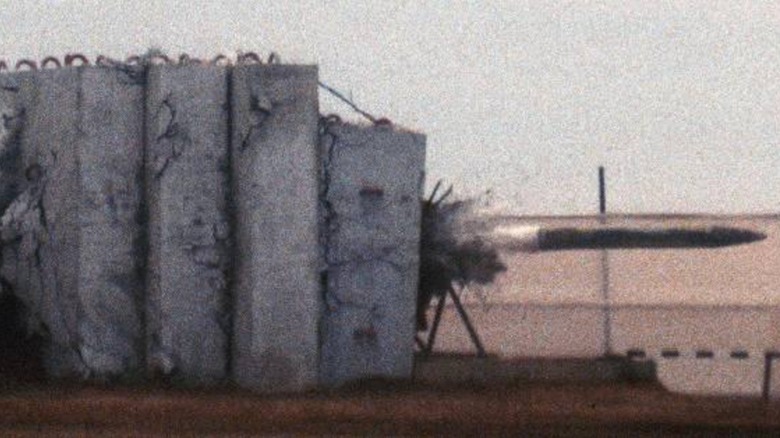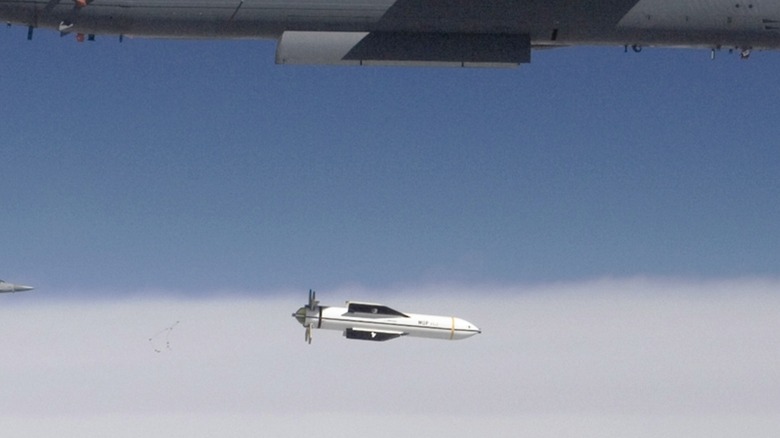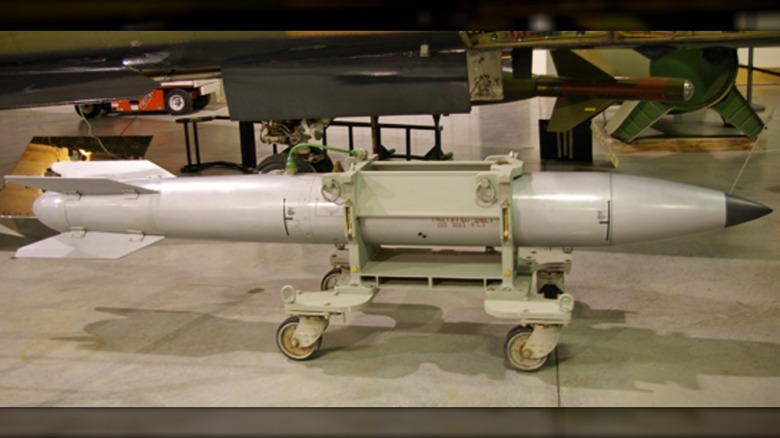How Deep Can A Bunker Buster Bomb Go?
Much of the world learned of the existence of so-called "bunker busters" when the United States bombed targets in Iran in June 2025. Yet this type of ordnance has actually been around since World War II, when the Luftwaffe developed armor-piercing bombs intended for use against naval vessels and hardened fortifications. After the conflict ended, other nations got in on the game, and the United States used the ASM-A-1 Tarzon against hardened targets during the Korean War.
Given the fact that bunker busters are designed to penetrate deep into a site, whether it's covered with reinforced concrete or natural rock and earth, many wonder just how deep they can penetrate. Because there are so many different types of bunker busters, there isn't a single answer to the question. Still, looking at those developed by the U.S. after WWII, it's possible to see how far their capabilities have come since the first ones were used in the 1940s.
The U.S. notably produced a series of Paveway laser-guided bombs with attached penetrators. The first, the BLU-109, could drill about 5 feet, 9 inches deep. Over time, this capability was enhanced with the BLU-116 Advanced Unitary Penetrator, which allowed it to penetrate more than 11 feet into reinforced concrete. Following this, the BLU-113 Super Penetrator could go down as far as 20 feet, and the currently used model, the BLU-127, can penetrate over 200 feet, though the exact depth is classified.
The deepest penetrating bunker buster is currently a massive 30,000-pound bomb
Bunker buster bombs use advanced science to function, as they must literally penetrate deep into a target location before detonating. The one currently in use by the United States is the GBU-57/A/B Massive Ordnance Penetrator (MOP) with the BLU-127. It was used for the first time in the attack against Iran in Operation Midnight Hammer, and it appears to have worked as designed. The GBU-57 is massive, weighing in at 30,000 pounds., making it heavier than the legendary so-called "Mother of All Bombs."
The weight is required for penetration, but it's hardly the only aspect of the bomb's design that functions for that purpose. The bomb measures 20.5 feet in length and carries an explosive warhead weighing 5,300 pounds. That makes the bomb's primary heavy component its hardened penetrator, which is what enables the ordnance to penetrate over 200 feet of reinforced concrete or rock. It is guided via GPS and is 10 times more powerful than its predecessor, the BLU-109.
As it happens, while the GBU-57 functioned as designed in its only use in combat, the U.S. Air Force is already looking for a replacement. One of the main reasons for this is the delivery system, as currently, only the B-52 Stratofortress and B-2 Spirit stealth bomber can carry and deploy the MOP. With the B-21 Raider in development and the the Air Force eyeing to replace these legacy strategic bombers, it wants to continue being able to devastate hardened targets. Until that program comes to fruition, the GBU-57 will likely continue to operate for the Air Force.
There are also nuclear bunker busters
While almost all bunker buster bombs use conventional warheads, not all of them do. The United States uses the B-61 variable-yield thermonuclear gravity bomb as its primary nuclear bomb, and one model, the B-61 Mod 11, is a bunker buster variant. If you think a bunker can survive a surface detonation from a nuke, it's unlikely, though some can, depending on depth and other factors, which is why the B-61 Mod 11 was developed. Some might think that adding a nuclear warhead to a bunker buster is overkill, but there's a good reason for its creation.
A conventional bunker buster is designed to penetrate and destroy a single target. A nuclear model, on the other hand, is designed to take out an entire underground complex of bunkers and support structures. As you likely know, these weapons have never been used in combat — the only nuclear devices used in warfare came in World War II during the bombings of Hiroshima and Nagasaki, Japan. Despite this, around 50 B-61 Mod 11 nuclear bunker busters remain in the U.S.' inventory.
Instead of direct penetration, the B-61 Mod 11 is deployed in what is called a laydown mode. It uses a Kevlar parachute to slow its descent before landing on the ground, which also gives the aircraft that dropped it time to get to a safe distance. In ground-burst or laydown modes, the bomb's variable yield of between 0.3 and up to 340 kilotons suggests little beneath or around the bomb would survive detonation, including hardened bunkers buried as deep as 1,000 feet beneath ground zero.


